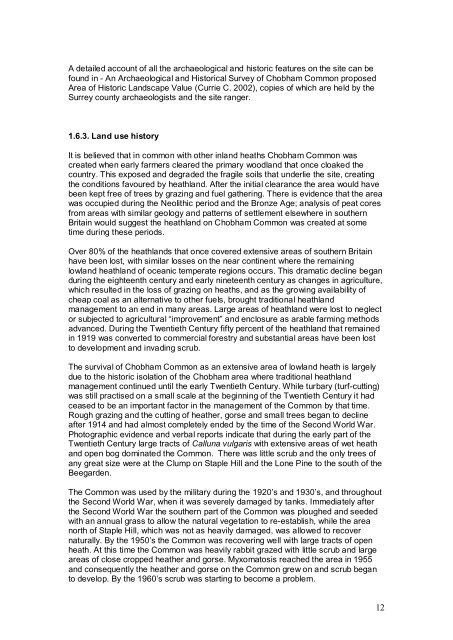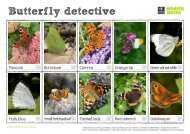CHOBHAM COMMON NNR - Surrey Wildlife Trust
CHOBHAM COMMON NNR - Surrey Wildlife Trust
CHOBHAM COMMON NNR - Surrey Wildlife Trust
Create successful ePaper yourself
Turn your PDF publications into a flip-book with our unique Google optimized e-Paper software.
A detailed account of all the archaeological and historic features on the site can be<br />
found in - An Archaeological and Historical Survey of Chobham Common proposed<br />
Area of Historic Landscape Value (Currie C. 2002), copies of which are held by the<br />
<strong>Surrey</strong> county archaeologists and the site ranger.<br />
1.6.3. Land use history<br />
It is believed that in common with other inland heaths Chobham Common was<br />
created when early farmers cleared the primary woodland that once cloaked the<br />
country. This exposed and degraded the fragile soils that underlie the site, creating<br />
the conditions favoured by heathland. After the initial clearance the area would have<br />
been kept free of trees by grazing and fuel gathering. There is evidence that the area<br />
was occupied during the Neolithic period and the Bronze Age; analysis of peat cores<br />
from areas with similar geology and patterns of settlement elsewhere in southern<br />
Britain would suggest the heathland on Chobham Common was created at some<br />
time during these periods.<br />
Over 80% of the heathlands that once covered extensive areas of southern Britain<br />
have been lost, with similar losses on the near continent where the remaining<br />
lowland heathland of oceanic temperate regions occurs. This dramatic decline began<br />
during the eighteenth century and early nineteenth century as changes in agriculture,<br />
which resulted in the loss of grazing on heaths, and as the growing availability of<br />
cheap coal as an alternative to other fuels, brought traditional heathland<br />
management to an end in many areas. Large areas of heathland were lost to neglect<br />
or subjected to agricultural “improvement” and enclosure as arable farming methods<br />
advanced. During the Twentieth Century fifty percent of the heathland that remained<br />
in 1919 was converted to commercial forestry and substantial areas have been lost<br />
to development and invading scrub.<br />
The survival of Chobham Common as an extensive area of lowland heath is largely<br />
due to the historic isolation of the Chobham area where traditional heathland<br />
management continued until the early Twentieth Century. While turbary (turf-cutting)<br />
was still practised on a small scale at the beginning of the Twentieth Century it had<br />
ceased to be an important factor in the management of the Common by that time.<br />
Rough grazing and the cutting of heather, gorse and small trees began to decline<br />
after 1914 and had almost completely ended by the time of the Second World War.<br />
Photographic evidence and verbal reports indicate that during the early part of the<br />
Twentieth Century large tracts of Calluna vulgaris with extensive areas of wet heath<br />
and open bog dominated the Common. There was little scrub and the only trees of<br />
any great size were at the Clump on Staple Hill and the Lone Pine to the south of the<br />
Beegarden.<br />
The Common was used by the military during the 1920’s and 1930’s, and throughout<br />
the Second World War, when it was severely damaged by tanks. Immediately after<br />
the Second World War the southern part of the Common was ploughed and seeded<br />
with an annual grass to allow the natural vegetation to re-establish, while the area<br />
north of Staple Hill, which was not as heavily damaged, was allowed to recover<br />
naturally. By the 1950’s the Common was recovering well with large tracts of open<br />
heath. At this time the Common was heavily rabbit grazed with little scrub and large<br />
areas of close cropped heather and gorse. Myxomatosis reached the area in 1955<br />
and consequently the heather and gorse on the Common grew on and scrub began<br />
to develop. By the 1960’s scrub was starting to become a problem.<br />
12



![Thursley Common [Shrike Hill] (SU9041) & Sheets Heath (SU9457 ...](https://img.yumpu.com/11846073/1/184x260/thursley-common-shrike-hill-su9041-sheets-heath-su9457-.jpg?quality=85)

